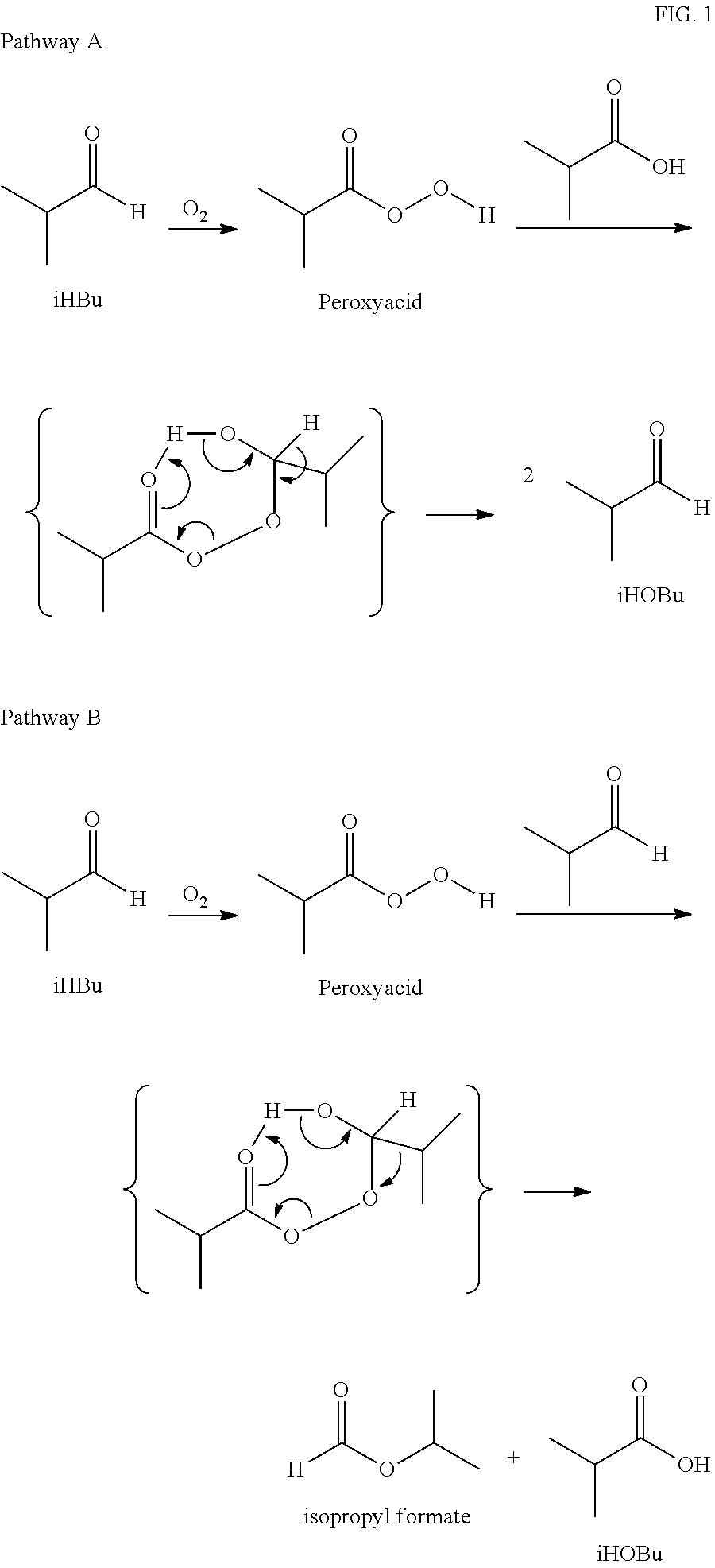Reduction of ester formation in isobutyraldehyde oxidation
a technology of isobutyraldehyde and ester, which is applied in the field of ester formation reduction in isobutyraldehyde oxidation, can solve the problems of loss of some of the ihbu feed, ipf not only consumes valuable raw materials, and reduces the production of desired acid
- Summary
- Abstract
- Description
- Claims
- Application Information
AI Technical Summary
Benefits of technology
Problems solved by technology
Method used
Image
Examples
example 1
Control, Oxidation of iHBu with 0% Acetone
[0026]The reactor is charged with 540 mL of isobutyric acid. After heating to 40° C. under 55 psig, iHBu is fed into the reactor at 1.5 mL / min. Air is fed into the reactor at 1 SLPM. Liquid overflow and gas effluent is collected, weighed, and analyzed by GC hourly. After 7 hours, the feeds are ceased, gas is vented, and the reactor is cooled, emptied, and its contents weighed and analyzed. The overflow was found to contain 91.0% isobutyric acid, 3.96% IPF, 2.48% acetone, 1.48% iHBu, 0.97% CO2 and 0.11% isopropanol.
example 2
Oxidation of iHBu with 5% Acetone
[0027]The reactor is charged with 540 mL of 95% isobutyric acid and 5% acetone. After heating to 40° C. under 55 psig, a mixture of 95% iHBu and 5% acetone is fed into the reactor at 1.5 mL / min. Air is fed into the reactor at 1 SLPM. Liquid overflow and gas effluent is collected, weighed, and analyzed by GC hourly. After 7 hours, the feeds are ceased, gas is vented, and the reactor is cooled, emptied, and its contents weighed and analyzed. The overflow was found to contain 86.0% isobutyric acid, 2.25% IPF, 8.72% acetone, 2.45% iHBu, 0.55% CO2, and 0.0% isopropanol.
example 3
Oxidation of iHBu with 10% Acetone
[0028]The reactor is charged with 540 mL of 90% isobutyric acid and 10% acetone. After heating to 40° C. under 55 psig, a mixture of 90% iHBu and 10% acetone is fed into the reactor at 1.5 mL / min. Air is fed into the reactor at 1 SLPM. Liquid overflow and gas effluent is collected, weighed, and analyzed by GC hourly. After 7 hours, the feeds are ceased, gas is vented, and the reactor is cooled, emptied, and its contents weighed and analyzed. The overflow was found to contain 79.5% isobutyric acid, 2.28% IPF, 14.71% acetone, 2.98% iHBu, 0.53% CO2, and 0.0% isopropanol.
PUM
| Property | Measurement | Unit |
|---|---|---|
| temperature | aaaaa | aaaaa |
| temperature | aaaaa | aaaaa |
| temperature | aaaaa | aaaaa |
Abstract
Description
Claims
Application Information
 Login to View More
Login to View More - R&D
- Intellectual Property
- Life Sciences
- Materials
- Tech Scout
- Unparalleled Data Quality
- Higher Quality Content
- 60% Fewer Hallucinations
Browse by: Latest US Patents, China's latest patents, Technical Efficacy Thesaurus, Application Domain, Technology Topic, Popular Technical Reports.
© 2025 PatSnap. All rights reserved.Legal|Privacy policy|Modern Slavery Act Transparency Statement|Sitemap|About US| Contact US: help@patsnap.com

